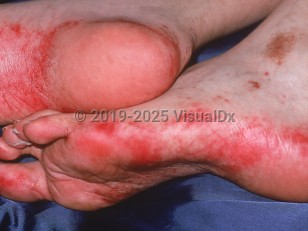Reactions may occur sooner (24 hours to 3 weeks) and more severely with bolus chemotherapy than with low-dose continuous infusion and are usually reproducible with challenge. It is characterized by a painful erythematous rash, often associated with edema located on the palms, fingers, and soles, preceded by dysesthesia.
Acral erythema may occur as part of a broader eruption, known as toxic erythema of chemotherapy (TEC). Variant presentations of acral erythema and TEC include:
- Malignant intertrigo: This variant involves the axillary folds, antecubital / popliteal fossae, neck, inguinal folds, buttocks, and genitals. Involvement of the ears can be seen following cytarabine treatment.
- Periarticular thenar erythema with onycholysis (PATEO) syndrome: Has distinct nail changes and involvement of the dorsal hands and/or base of the thumb. This variant is often associated with taxanes.
- Fixed erythrodysesthesia plaque: This lesion is usually a fixed erythematous plaque at the infusion site and does not involve the palms of the hands or the soles of the feet. It commonly occurs with intravenous injections of docetaxel.
- Stevens-Johnson syndrome / toxic epidermal necrolysis (SJS/TEN)-like presentation: This is a bullous variant that has been reported following cytarabine or high-dose methotrexate, particularly in children, and following enfortumab.



